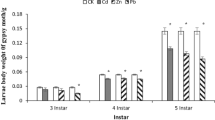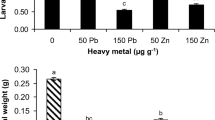Abstract
Lymantria dispar (gypsy moth) larvae were reared on both a natural diet of oak leaves and an artificial medium contaminated independently with four different metal nitrates. Larvae were contaminated up to pupation either from 1st or 4th instars at four concentrations differing by a factor of 5. The lowest concentration levels were 2 μg/g Cd, 4 μg/g Pb, 10 μg/g Cu, and 100 μg/g Zn based on nutrient medium dry weight. Developmental rate, growth, mortality and reproductive success were determined. No-Observed-Effect-Concentrations (NOECs) calculated were dependent on the metal, the parameter investigated and the stage at which exposure commenced. In general, larvae exposed from the 4th instar were less susceptible to metal toxification than those exposed from hatching. Considering all parameters investigated, dietary NOECs were determined to be 2 μg/g Cd, 4 μg/g Pb, 10 μg/g Cu, and 100 μg/g Zn.
Similar content being viewed by others
References
Bell RA, Owens CD, Shapiro M, Tardif JR (1981) Mass rearing and virus production. In: Doane CC, McManus ML (eds) The gypsy moth: Research toward integrated pest management. Forest Service, Science and Education Agency, Technical Bulletin 1584 US Department of Agriculture, Washington, DC
Capinera JL, Barbosa P, Hagedorn HH (1977) Yolk and yolk depletion of gypsy moth eggs: Implications for population quality. An Entomol Soc Am 70:40–42
Gahukar RT (1975) Effects of dietary zinc sulphate on the growth and feeding behaviour of Ostrinia nubilalis Hbn. (Lep., Pyraustidae). Z Ang Ent 79:352–357
Giese RL, Casagrande RA (1981) Egg development and diapause. In: Doane CC, McManus ML (eds) The gypsy moth: Research toward integrated pest management. Forest Service, Science and Education Agency, Technical Bulletin 1584, US Department of Agriculture, Washington, DC, pp 145–160
Kurir A (1950) Vergrößerung der Zahl der Raupenstadien und Verlängerung des Raupenlebens durch die Nahrung. Die Bodenkultur 6:355–382
Leonard DE (1970) Effects of starvation on behavior, number of larval instars, and development rate of Porthetria dispar. J Insect Physiol 16:25–31
Miyoshi T, Miyazawa F, Shimizu O (1971) Effects of heavy metals on the mulberry plant and silkworm. I. Effects of cadmium and zinc on silkworm larvae Bombyx mori L. J Seric Sci Jpn 40:323–329
Miyoshi T, Miyazawa F, Shimizu O, Machida J (1978) Effects of heavy metals on the mulberry plant and silkworm. II. Effect of dietary lead, copper and arsenite on silkworm larvae Bombyx mori L. J Seric Sci Jpn 47:70–76
Pascoe D, Williams KA, Green DWJ (1989) Chronic toxicity of cadmium to Chironomus riparius Meigen—effects upon larval development and adult emergence. Hydrobiologia 175:109–115
Salama HS, El-Sharaby (1973) Effect of zinc sulphate on the feeding and growth of Spodoptera littoralis Boisd. Z Ang Ent 72:383–389
Sell DK, Bodznick DA (1971) Effects of dietary ZnSO4 on the growth and feeding of the tobacco budworm, Heliothis virescens. Ann Entomol Soc Am 64:850–855
Sivapalan P, Gnanapragasam NC (1980) Influence of copper on the development and adult emergence of Homona coffearia (Lepidoptera: Tortricidae) reared in vitro. Entomol exp appl 28:59–63
Timmermans KR, Peeters W, Tonkes M (1991) Cadmium, zinc, lead and copper in larvae of Chironomus riparius (Meigen) (Diptera; Chironomidae): uptake and effects. In: Timmermans KR (ed) Trace metal ecotoxicokinetics of Chironomids, Academisch Proefschrift, Univ. Amsterdam, pp 87–121
Van Straalen NM, Schobben JHM, De Guede RGM (1990) Population consequences of cadmium toxicity in soil microarthropods. Ecotoxicol Environ Saf 17:190–204
Williams KA, Green DWJ, Pascoe D, Gower DE (1986) The acute toxicity of cadmium to different larval stages of Chironomus riparius (Diptera: Chironomidae) and its ecological significance for pollution regulation. Oecologia (Berl) 70:362–366
Zelenayova E (1986) Scotia segetum (Lepidoptera, Noctuidae) oogenesis affected by copper ions added to semisynthetic diet of larvae. Biologia (Bratislava) 41:563–577
Zenner-Polania I, Helgesen RG (1973) Effect of temperature on instar number and head-capsule width of Platynota stultana (Lepidptera: Torticidae). Environ Entomol 2:823–827
Author information
Authors and Affiliations
Rights and permissions
About this article
Cite this article
Gintenreiter, S., Ortel, J. & Nopp, H.J. Effects of different dietary levels of cadmium, lead, copper, and zinc on the vitality of the forest pest insect Lymantria dispar L. (Lymantriidae, Lepid). Arch. Environ. Contam. Toxicol. 25, 62–66 (1993). https://doi.org/10.1007/BF00230712
Received:
Revised:
Issue Date:
DOI: https://doi.org/10.1007/BF00230712




